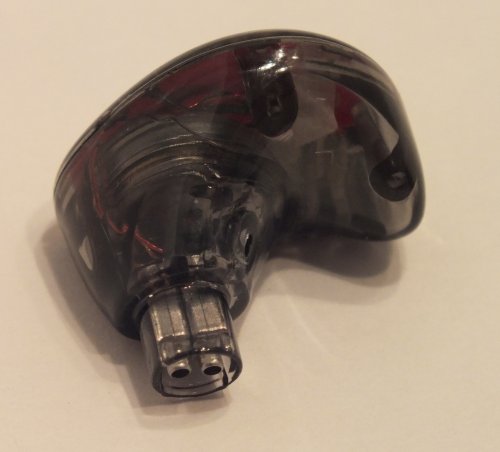
Disclaimer: Kinboofi provided the TRN V30 for review based on my previous conversation surrounding the TRN v20 with their rep. Worth noting, Kinboofi lists a 12 month warranty if purchased through their Amazon store. If interested, the v30 can be purchased here.
Unboxing / Packaging:
The TRN v30 arrived packaged in a slip-cover with a book-fold style box inside. Specs on the outside of the box are a more western style package and would seem at home on a shelf at best buy or the typical electronics store. The earpieces themselves rest in a foam tray with all the other goodies hiding underneath. The kit is fairly basic with 3 sets of tips, the cable, and various cards and instructions.


 Cable:
Cable:
The cable outwardly appears to be identical to the V20 version. It is 4 core oxygen free copper in a twist pattern of two cores twisted together and then the two pairs twisted together from the straight 3.5mm jack to the semi dumbell shaped splitter. Coating is pvc and feels a bit like plastic but resists tangles well if not the most pliable option available. Above the split, twisted pairs run to pre-formed earhooks (sans memory wire) and then to black plastic .75mm bi-pin connector housings. Overall, TRN has done a good job with cables and the one included with the V30 is a solid effort even if I would prefer the 90º jack and a chin slider.


 Build/Fit:
Build/Fit:
Build quality on the V30 is a mixed bag. Shells are transparent smoked plastic and are well put together with no slop at the seams. Some will immediately liken the v30 to the AS06 or AS10 shape but it is smaller in most dimensions especially in thickness which I find makes it sit in the ear more comfortably. As good as the shell construction is, they are not without problems. They ship with mid sized tips and in exchanging them for the large size I usually use, one of the grills fell off the nozzle. Within a week, the second grill had fallen off even with a tip in place to hold it on. Nozzles do not have a true lip but do have a series of raised studs around the rim to hold tips in place (these can be felt with a fingernail more easily than seen due to the shell color - see red arrows). I will say that when the first thing you see is the dual BAs aimed straight at your eardrum with no form of damping or filtering. I was a bit apprehensive about what these might sound like.




 Internals:
Internals:
A single 10mm polymer dynamic driver sits behind two balanced armatures that TRN lists as being an inhouse built improvement on the Knowles 30017. The layout has the two BA drivers in the nozzle with the dynamic immediately behind them. (The upside of the grills falling of is clearer photos of the BAs). Nominal impedance is listed as 20Ω with a sensitivity of 99dB. I do have to call TRN out on the marketing material though, why post an FR chart and then note that it is not representative of the product? TRN also advertises holding the earpieces to within a 2dB tolerance they claim in 50% higher than the industry standard. My pair does indeed show good matching between the earpieces when tested.


 Sound:
Sound:
Defining the sound signature of the v30 is difficult in that none of the typical V, W, U designations are accurate. Sub-bass and mid-bass are elevated, lower mids are recessed, upper mids are mildly elevated, lower treble is lifted yet further, and then treble and upper treble falls back to a much more polite level. Probably the closest one can come to defining the signature shape would be a w with the right most leg removed. (Here i use the lower case for a reason as while some ranges are definitely ahead of others, none is so glaring so that it deserves the capital designation).
 Bass:
Bass:
Sub-bass rumble is good with roll-off becoming evident in the mid 40Hz range. Mid-bass is pushed forward mildly at around 100Hz and then drops as you move into the lower mids. While I found bass quantity to be very good, I found quality to be somewhat lacking in that the driver is a bit slow and lacked the ability to resolve details. This gives the v30 a bit of a one note bass at times as it didn't have the ability to create good separation between tones in the lower ranges. Orchestral pieces with a lot of low-end (Mussorgsky anyone?) suffered the most here while rock and pop that usually have a fairly uncomplicated bass sound considerably better.
Mids:
Mixed impressions here. Lower mids are recessed considerably and lack the kind of detail I would have liked to see. As you climb, they begin to move forward and by the upper mids, a considerable amount of detail is added and they have moved forward quite a bit. Still not to the level of the mid-bass but enough to be much more acceptable in my eyes. This creates a dichotomy as lower range vocals do not have much texture while upper range vocals are much more lifelike and engaging. The lack of lower mids also created similar problems for strings as they sounded thin and unnatural at times.
Treble:
Treble is tuned with a forward lower treble followed by a fairly steep roll-off. This removes any tendency toward sibilance or stridency, but also limits air at the top end and makes snare and cymbals sound a bit dull. Detail in the treble is quite good (as one might expect with twin BAs immediately inside your ear) and clarity in the upper ranges is surprisingly good. TRN's claim to have improved the Knowles 30017 seems founded when looking at the treble alone (if not so much the mids). The one drawback is they do exhibit some of the characteristic BA sound signature and are a bit dry and thinner than perfect. (This is hardly a knock at the price point, just more of an observation).
Soundstage / Imaging:
Soundstage is more wide than deep and feels confined without feeling congested. They do have some sense of height, but it is fairly limited and as such these feel like the music is mostly in your head rather than out in front of you. Imaging is good, but not great as instrument separation suffers as tracks get busier. This is particularly true when a fast complex bass-line is introduced as the dynamic driver is a bit slower on both attack and decay than the BA drivers and tends to "gum up" more quickly.
Thoughts / Conclusion:
If you got the feeling that I am somewhat confused when it comes to the v30 you'd be right. It does a lot well and the tuning will appeal to many. It would be easy to say it is the Tin Audio T2 with slightly more bass and a bit more polite treble but then the lack of lower mids sneak in and ruin the thought. Next song, wow these are better than the ZsN easily and then lack of detail in the bass becomes evident. Finally I start comparing to KB-100 and again the V30 does a lot equally well or better but then you get a lack of dynamics where the Kb-100 takes over and the v30 struggles. Overall, is the TRN v30 an improvement over the previous generation v20? Yes, very much so. Is it an improvement over the v80? Again for me yes, gone is 90% of the grain in the treble that killed the v80 for me. Is it perfect? It was $27 were you honestly expecting that? Bottom line, well tuned, very polite, good bass depth, and enjoyable with popular genres that don't get excessively busy or rely on lower mids too heavily.

























